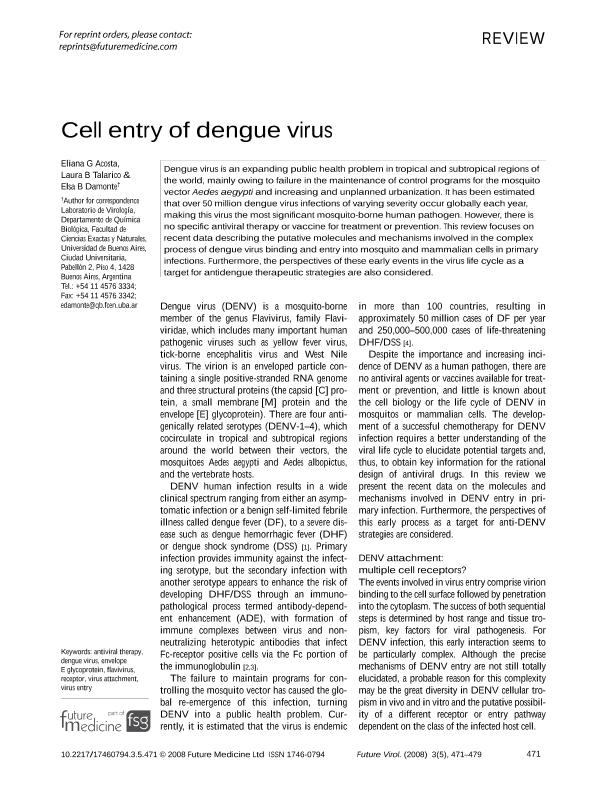Mostrar el registro sencillo del ítem
dc.contributor.author
Acosta, Eliana Gisela

dc.contributor.author
Talarico, Laura Beatriz

dc.contributor.author
Damonte, Elsa Beatriz

dc.date.available
2019-09-25T18:48:02Z
dc.date.issued
2008-09
dc.identifier.citation
Acosta, Eliana Gisela; Talarico, Laura Beatriz; Damonte, Elsa Beatriz; Cell entry of dengue virus; Future Medicine; Future Virology; 3; 5; 9-2008; 471-479
dc.identifier.issn
1746-0794
dc.identifier.uri
http://hdl.handle.net/11336/84429
dc.description.abstract
Dengue virus is an expanding public health problem in tropical and subtropical regions of the world, mainly owing to failure in the maintenance of control programs for the mosquito vector Aedes aegypti and increasing and unplanned urbanization. It has been estimated that over 50 million dengue virus infections of varying severity occur globally each year. making this virus the most significant mosquito-borne human pathogen. However, there is no specific antiviral therapy or vaccine for treatment or prevention. This review focuses on recent data describing the putative molecules and mechanisms involved in the complex process of dengue virus binding and entry into mosquito and mammalian cells in primary infections. Furthermore, the perspectives of these early events in the virus life cycle as a target for antidengue therapeutic strategies are also considered.
dc.format
application/pdf
dc.language.iso
eng
dc.publisher
Future Medicine

dc.rights
info:eu-repo/semantics/openAccess
dc.rights.uri
https://creativecommons.org/licenses/by-nc-sa/2.5/ar/
dc.subject
ANTIVIRAL THERAPY
dc.subject
DENGUE VIRUS
dc.subject
ENVELOPE E GLYCOPROTEIN
dc.subject
FLAVIVIRUS
dc.subject
RECEPTOR
dc.subject
VIRUS ATTACHMENT
dc.subject
VIRUS ENTRY
dc.subject.classification
Virología

dc.subject.classification
Ciencias Biológicas

dc.subject.classification
CIENCIAS NATURALES Y EXACTAS

dc.title
Cell entry of dengue virus
dc.type
info:eu-repo/semantics/article
dc.type
info:ar-repo/semantics/artículo
dc.type
info:eu-repo/semantics/publishedVersion
dc.date.updated
2019-03-27T17:07:50Z
dc.journal.volume
3
dc.journal.number
5
dc.journal.pagination
471-479
dc.journal.pais
Reino Unido

dc.journal.ciudad
Londres
dc.description.fil
Fil: Acosta, Eliana Gisela. Consejo Nacional de Investigaciones Científicas y Técnicas; Argentina. Universidad de Buenos Aires. Facultad de Ciencias Exactas y Naturales. Departamento de Química Biológica. Laboratorio de Virología; Argentina
dc.description.fil
Fil: Talarico, Laura Beatriz. Consejo Nacional de Investigaciones Científicas y Técnicas; Argentina. Universidad de Buenos Aires. Facultad de Ciencias Exactas y Naturales. Departamento de Química Biológica. Laboratorio de Virología; Argentina
dc.description.fil
Fil: Damonte, Elsa Beatriz. Consejo Nacional de Investigaciones Científicas y Técnicas; Argentina. Universidad de Buenos Aires. Facultad de Ciencias Exactas y Naturales. Departamento de Química Biológica. Laboratorio de Virología; Argentina
dc.journal.title
Future Virology

dc.relation.alternativeid
info:eu-repo/semantics/altIdentifier/doi/https://doi.org/10.2217/17460794.3.5.471
dc.relation.alternativeid
info:eu-repo/semantics/altIdentifier/url/https://www.futuremedicine.com/doi/10.2217/17460794.3.5.471
Archivos asociados
